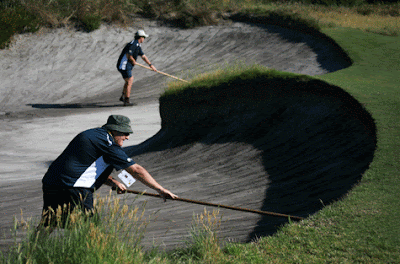There have been a lot of complimentary comments about the River greens lately which is a nice way to go in to Christmas. There are a number of factors involved but probably most importantly was the effort put in for the Greg Norman Foundation junior tournament in early December, particularly during the tournament. Time for preparation was available during tournament week due to a 5.30 am start for the staff and a 6.40 am 2 tee start for the players (who were also very slow) which gave us an hours break on the play. I invested 6 staff per morning on the River greens alone which when you consider I only had 13 staff that week was a large investment and one that I normally couldn't afford. It allowed me to get the greens double cut and double rolled each morning before play and the results were obvious as there is no doubt that the greens played as well as they have ever done for the tournament.
The preparation time is the critical factor as not only were the greens double cut but they were "slow" double cut. By this I mean that the machine travels at snails pace across the green which increases the clip rate and therefore quality of cut. Essentially the slower you mow the more times the blades strike the grass resulting in a finer and more even cut. This takes time and manpower and on a course as busy as ours can't always be done. We generally have to race to beat the play and the next few weeks are a perfect example with 6.00 am starts the norm with both courses heavily booked and the first groups generally playing in less than 3 hours. An old adage on bowling greens is the best greens have the greenkeepers heel marks in them as he digs in to try and slow the speed of the mower down to improve the cut.
The different renovation technique used this year was also a factor as the damage to the greens at the renovation was much less than normal which resulted in a faster recovery. Keeping the greens where they are at the moment, which is on the edge, is not sustainable on a year round basis as we need to have healthy grass cover to deal with our shade and player number issues.
The different renovation technique used this year was also a factor as the damage to the greens at the renovation was much less than normal which resulted in a faster recovery. Keeping the greens where they are at the moment, which is on the edge, is not sustainable on a year round basis as we need to have healthy grass cover to deal with our shade and player number issues.
The new fairway mowers arrived last week and have already got the fairways in great shape. There will be some initial scalping in some areas as the heads are slightly smaller than our old ones and therefore tend to dig in a bit in some of the uneven areas on the fairways. The new fairway shapes are starting to become well and truly evident and we now have a distinguishable fairway and the place looks like a golf course.
The burn heap has been mulched and some of the mulch has been transported up to the grassed area at the rear of the buggy shed where Members are free to help themselves. It was interesting as I re-read this that I referred to the tree pile as the burn heap. Its funny how names of things stick on golf courses. At Cool Tweed we have the burn heap that hasn't had anything burned (legally) for over 10 years. We also have the "junior putter" which is the grassed area out the front of the "old Pro Shop" that hasn't been used as a putting green for over 15 years that I know of and the old Pro Shop has been a buggy storage shed now for how long?
On behalf of my staff I take this opportunity to wish all Members and readers a Merry Christmas and a safe New Year. And a special thanks to those members who sent cards and Christmas goodies to my staff....it's great for staff morale. Thank you.
On behalf of my staff I take this opportunity to wish all Members and readers a Merry Christmas and a safe New Year. And a special thanks to those members who sent cards and Christmas goodies to my staff....it's great for staff morale. Thank you.













































